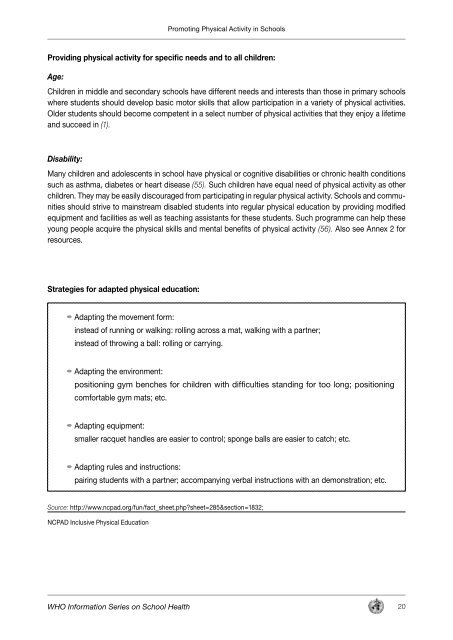WHO INFORMATION SERIES ON SCHOOL HEALTH ... - PAHO/WHO
WHO INFORMATION SERIES ON SCHOOL HEALTH ... - PAHO/WHO
WHO INFORMATION SERIES ON SCHOOL HEALTH ... - PAHO/WHO
Create successful ePaper yourself
Turn your PDF publications into a flip-book with our unique Google optimized e-Paper software.
Promoting Physical Activity in Schools<br />
Providing physical activity for specific needs and to all children:<br />
Age:<br />
Children in middle and secondary schools have different needs and interests than those in primary schools<br />
where students should develop basic motor skills that allow participation in a variety of physical activities.<br />
Older students should become competent in a select number of physical activities that they enjoy a lifetime<br />
and succeed in (1).<br />
Disability:<br />
Many children and adolescents in school have physical or cognitive disabilities or chronic health conditions<br />
such as asthma, diabetes or heart disease (55). Such children have equal need of physical activity as other<br />
children. They may be easily discouraged from participating in regular physical activity. Schools and communities<br />
should strive to mainstream disabled students into regular physical education by providing modified<br />
equipment and facilities as well as teaching assistants for these students. Such programme can help these<br />
young people acquire the physical skills and mental benefits of physical activity (56). Also see Annex 2 for<br />
resources.<br />
Strategies for adapted physical education:<br />
Adapting the movement form:<br />
instead of running or walking: rolling across a mat, walking with a partner;<br />
instead of throwing a ball: rolling or carrying.<br />
Adapting the environment:<br />
positioning gym benches for children with difficulties standing for too long; positioning<br />
comfortable gym mats; etc.<br />
Adapting equipment:<br />
smaller racquet handles are easier to control; sponge balls are easier to catch; etc.<br />
Adapting rules and instructions:<br />
pairing students with a partner; accompanying verbal instructions with an demonstration; etc.<br />
Source: http://www.ncpad.org/fun/fact_sheet.php?sheet=285§ion=1832;<br />
NCPAD Inclusive Physical Education<br />
<strong>WHO</strong> Information Series on School Health 20

















